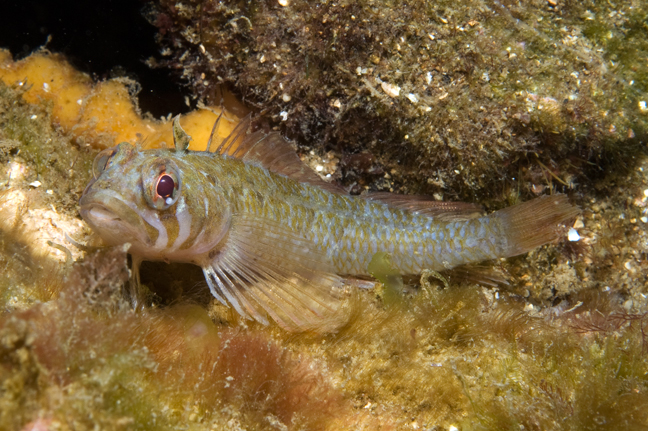Clark's Threefin, Trinorfolkia clarkei (Morton 1888)
Other Names: Clark's Triplefin, Common Threefin, Macleay's Threefin, Rock Blenny

Clark's Threefin, Trinorfolkia clarkei, at Popes Eye, Port Phillip, Victoria. Source: Julian K. Finn / Museums Victoria. License: CC by Attribution
Summary:
A variable grey to brown or orange threefin usually with seven darker bars along the back that are divided ventrally, a prominent bar below the eye that curves backwards, and often a large black blotch on the first dorsal fin.
Cite this page as:
Bray, D.J. 2021, Trinorfolkia clarkei in Fishes of Australia, accessed 06 Jul 2025, https://fishesofaustralia.net.au/home/species/29
Clark's Threefin, Trinorfolkia clarkei (Morton 1888)
More Info
|
Distribution |
Endemic to southern Australia from Minnie Waters, New South Wales, to Rottnest Island, Western Australia, including around Tasmania. Inhabits coastal reefs and estuaries, and often seen around jetty pylons. |
|
Features |
Dorsal fin III- IV + XII-XV + 10-12; Anal fin II, 19-21; Caudal fin 13; Pectoral fin 15-16; Pelvic fin I, 2; Lateral line scales (upper) 25-30. Body moderately elongate, shallow (approx. 20% SL), almost cylindrical, slightly compressed. Head moderately large (approx. 32% SL), pointed; eyes large (approx. 30% HL); multilobate, fleshy tentacle with long fringes above each eye; anterior nostril tubular with simple lobate tentacle; mouth large, reaching below centre of eyes, slightly oblique; teeth pointed, set in bands, outer rows widely spaced and enlarged. Scales ctenoid, large on body, small on head and belly, covering trunk, top of head to eyes, most of operculum, upper part of preopercle, but not pectoral base; lateral line in two parts, upper section running from upper end of opercular opening, following contour of back, to below third dorsal fin, lower section represented by posteriorly notched scales, only some of which have pores, originating below origin of upper section, curving downwards behind pectoral fin to midline of side, portion below upper section poorly developed and with very few notched scales, those below and behind upper section notched; pores on head large and numerous. Dorsal fin in three sections, first much shorter and usually much lower than second, first and second spinous, third with simple or branched soft rays; anal fin with elongate base and uniform height; caudal rounded. Pectoral fins large, uppermost ray simple and short, other rays in upper half of fin branched to base, rays in lower half simple but strong, middle rays longest, reaching past centre of second dorsal fin. Pelvic fins simple, jugular, inserted anterior to first dorsal fin origin. |
|
Colour |
Colour extremely variable with habitat, ranging from grey to brown or orange, usually with seven evenly spaced darker bars dorsally, bars divided ventrally; usually with very distinct bar under eyes curving backwards; first dorsal often with large black spot; dorsal and anal fins with wavy lines or evenly pale yellow to deep orange. |
|
Similar Species |
The similar Trinorfolkia incisa has deeply incised or indented membranes on the first dorsal fin. The Crested Threefin, Trinorfolkia cristata, which occurs in South Australia, has a very tall first dorsal fin. |
|
Etymology |
The species is named for the type locality, Clarke Island in Bass Strait, Tasmania. |
|
Species Citation |
Tripterygium clarkei Morton 1888. Pap. Proc. Roy. Soc. Tas. 1887: 78. Type locality: Clarke Island, Bass Strait, Tasmania. |
|
Author |
Bray, D.J. 2021 |
|
Resources |
Clark's Threefin, Trinorfolkia clarkei (Morton 1888)
References
Edgar, G.J. 2008. Australian Marine Life: the plants and animals of temperate waters. Sydney : Reed New Holland 2nd edn, 624 pp.
Fricke, R. 1994. Tripterygiid fishes of Australia, New Zealand and the Southwest Pacific Ocean, with descriptions of 2 new genera and 16 species (Teleostei). Theses Zoologicae 24: 1-585 figs 1-130
Gomon, M.F. 2008. Family Tripterygiidae. pp. 684-693 in Gomon, M.F., Bray, D.J. & Kuiter, R.H. (eds). Fishes of Australia's Southern Coast. Sydney : Reed New Holland 928 pp.
Hutchins, J.B. & Swainston, R. 1986. Sea Fishes of Southern Australia. Complete field guide for anglers and divers. Perth : Swainston Publishing 180 pp.
Kuiter, R.H. 1986. A new genus and three new species of tripterygiid fishes of Australia's south coast. Revue Française d'Aquariologie et Herpétologie 12(3): 89-96 9 figs (as Norfolkia clarkei)
Kuiter, R.H. 1993. Coastal Fishes of South-eastern Australia. Bathurst : Crawford House Press 437 pp.
Kuiter, R.H. 1994. Families Blenniidae and Tripterygiidae. pp. 728-740 in Gomon, M.F., Glover, C.J.M. & Kuiter, R.H. (eds). The Fishes of Australia's South Coast. Adelaide : State Printer 992 pp. 810 figs.
Kuiter, R.H. & Kuiter, S.L. 2018. Fish watchers guide to coastal sea-fishes of south-eastern Australia. Seaford, Victoria : Aquatic Photographics, 371 pp.
Last, P.R., Scott, E.O.G. & Talbot, F.H. 1983. Fishes of Tasmania. Hobart : Tasmanian Fisheries Development Authority 563 pp. figs.
Lucas, A.H.S. 1891. On the occurrence of certain fish in Victorian seas, with descriptions of some new species. Proceedings of the Royal Society of Victoria ns 3(2): 8-14 pl. 3, (described as Tripterygium macleayanum), See ref at BHL
Morton, A. 1888. Description of two new fishes. Papers and Proceedings of the Royal Society of Tasmania 1887: 77-78 fig. 1 See ref online
Ramsay, E.P. & Ogilby, J.D. 1888. Description of a new Tripterygium from Port Jackson. Proceedings of the Linnean Society of New South Wales 3(2): 419-420 (described as Tripterygion striaticeps)
Scott, E.O.G. 1977. Observations on some Tasmanian fishes. Part 23. Papers and Proceedings of the Royal Society of Tasmania 111: 111-180 figs 1-3 (as Helcogramma clarkei & described as Tripterygion whitleyi)
Thomson, J.M. 1978. A Field Guide to the Common Sea & Estuary Fishes of Non-tropical Australia. Sydney : Collins 144 pp.
Williams, J. & Holleman, W. 2014. Trinorfolkia clarkei. The IUCN Red List of Threatened Species 2014: e.T179024A1560736. https://dx.doi.org/10.2305/IUCN.UK.2014-3.RLTS.T179024A1560736.en. Downloaded on 01 December 2020.









